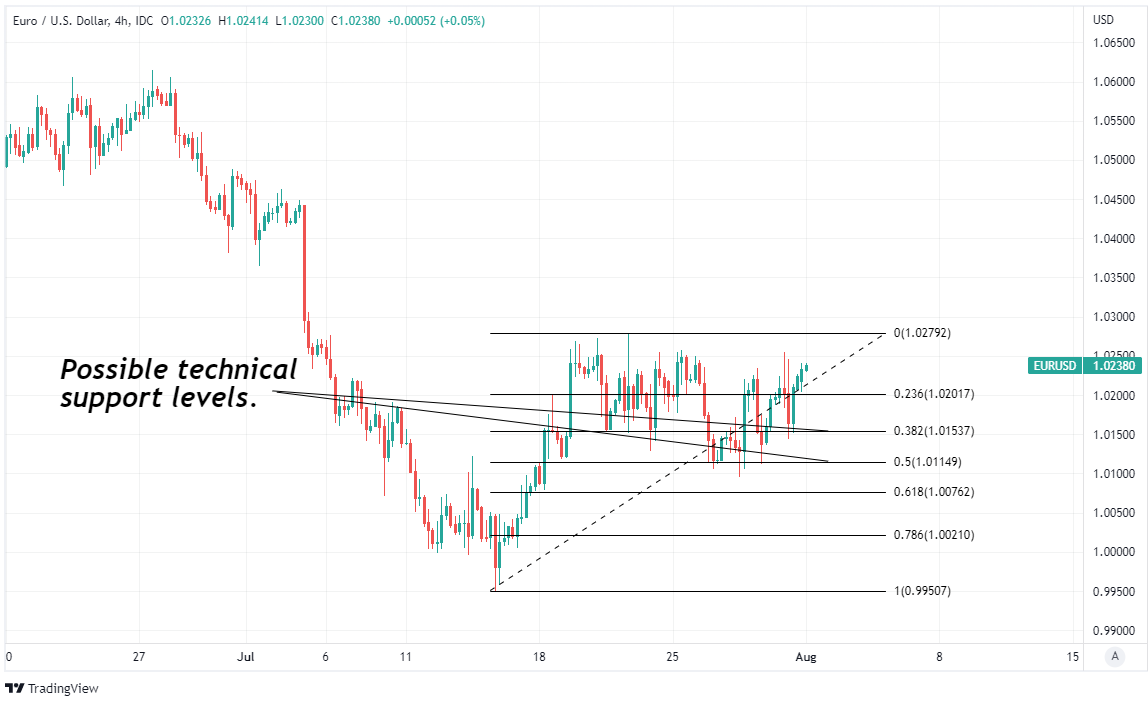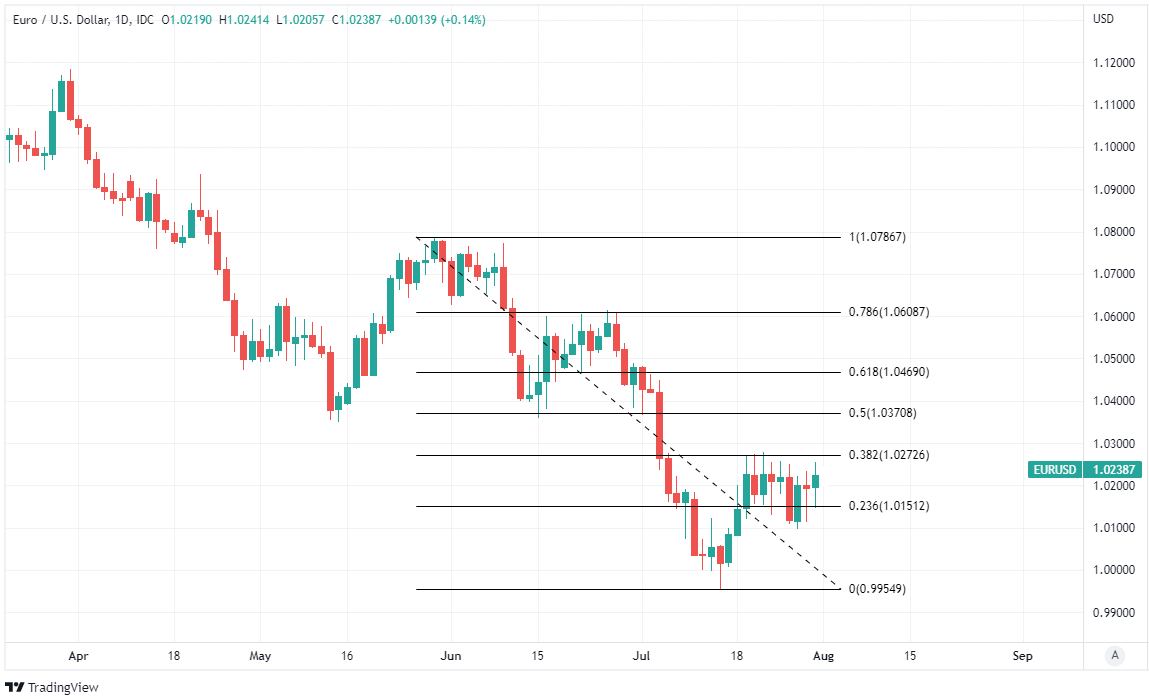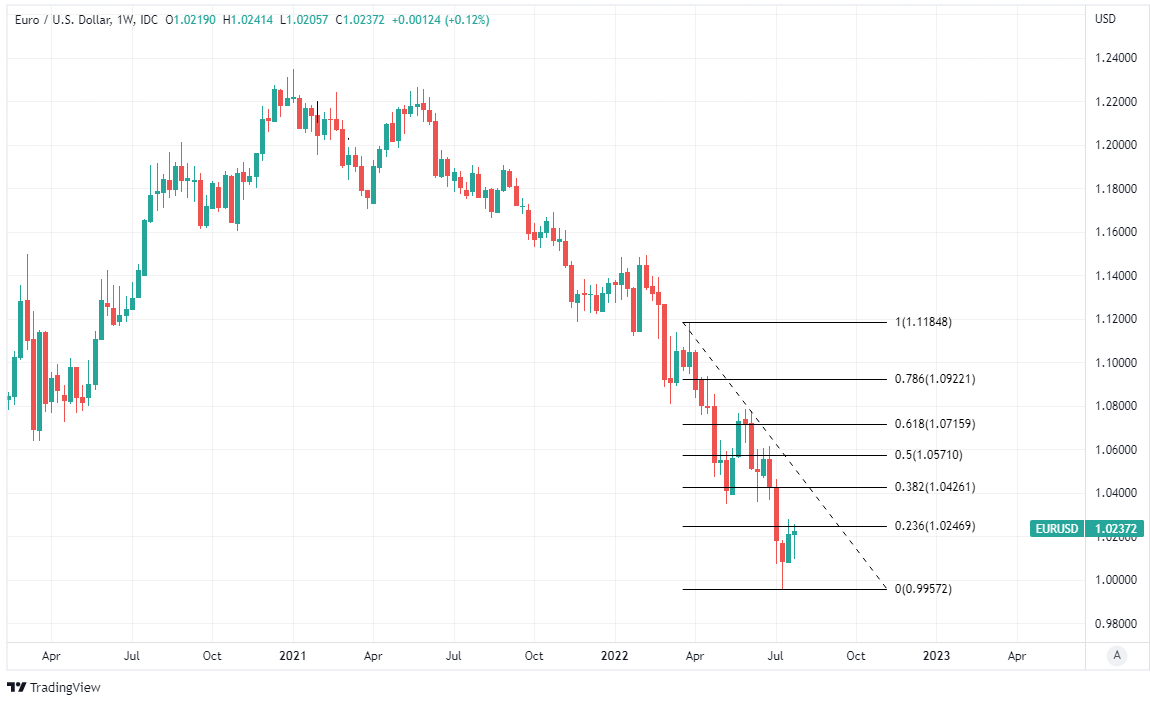EUR/USD Rate Week Ahead Forecast: Entering Data Gauntlet On Firmer Footing
- Written by: James Skinner
- EUR/USD on firmer footing following GDP, Fed
- But risks setback on looming U.S. data gauntlet
- Finding short-term technical support at 1.0116
- Technical resistances around 1.0246 & 1.0272
- U.S. ISM surveys, payrolls & Fed speak ahead

Image © European Central Bank
The Euro to Dollar exchange rate eked out only a fractional gain over a falling greenback during recent days but enters the new week on a firmer footing and could perform better in the period ahead if the single currency navigates successfully a looming gauntlet of U.S. economic data risks.
Europe’s single currency came under pressure across the board last week amid an intense market focus on falling European gas supplies that pushed prices higher briefly and led the European Union to agree to a rationing plan that could further hamper continental economies over the winter.
This Russian protest over sanctions relating to its invasion of Ukraine handicapped the Euro-Dollar rate last week but was not enough to push it below the level of technical support emerging around 1.0116, which the single currency tested but held on multiple occasions.
Euro losses were limited by a Dollar that sold off in the wake of Wednesday’s Federal Reserve decision, and it now enters the new week on a firmer footing with technical resistances around 1.0246 and 1.0272 in its crosshairs.
“After the Fed signalled that the pace of rate hikes is likely to slow going forward and has made future policy decisions more data dependent, we decided that the risk reward balance of remaining long USDs in the near-term was not as favourable,” says Lee Hardman, a currency analyst at MUFG.
 Above: Euro to Dollar rate shown at 4-hour intervals with Fibonacci retracements of mid-July fall indicating possible areas of technical support for the Euro. Click image for closer inspection.
Above: Euro to Dollar rate shown at 4-hour intervals with Fibonacci retracements of mid-July fall indicating possible areas of technical support for the Euro. Click image for closer inspection.
The Dollar’s reaction to last week’s Federal Reserve decision led Hardman and colleagues to suggest that institutional clients of the bank book profit and walk away from an earlier bet against the single currency, which had fallen briefly below parity with the greenback during the middle stage of July.
“While we do not expect the USD sell-off to prove sustainable, we prefer to cut back long USD exposure until the dust settles. The euro-zone economic data releases have also been more supportive than expected for the euro over the past week,” Hardman said on Friday.
The Euro has also been helped onto a firmer footing by second quarter GDP and July inflation data out on Friday, which suggested the Euro Area economies held up better than many had feared during the opening half of the year.
Europe’s economy grew by 0.7% in the three months to the end of June following an upwardly-revised 0.6% expansion to open the year while overall and core measures of inflation rose further than expected for July, with possible implications for European Central Bank (ECB) policy.
“Our economists now expect the Euro area to be in recession in the second half of this year; spot data are already slowing materially and further production disruptions are likely,” warns Michael Cahill, a G10 FX strategist at Goldman Sachs, citing lingering risks to Europe’s gas supplies.
 Above: Euro to Dollar rate shown at daily intervals with Fibonacci retracements of June fall indicating possible areas of technical resistance for the Euro. Click image for closer inspection.
Above: Euro to Dollar rate shown at daily intervals with Fibonacci retracements of June fall indicating possible areas of technical resistance for the Euro. Click image for closer inspection.
“Based on our metrics, the recent recovery in EUR/USD is not entirely justified by the news flow and the market still has some work to do to price our new baseline outlook, as well as put some weight on more severe outcomes,” Cahill and colleagues said on Friday.
Many analysts and economists do remain bearish in their outlooks for the single currency and European economies, however, although not everybody is of this school of thought and the Euro enters the new week on a firmer footing than it was at any point in July.
"The key point is that the market consensus is centered around the Fed being the most hawkish central bank. That will face a critical test in the next few months, if the world enters a recession. This is especially true in the euro area," says Chester Ntonifor, chief forex strategist at BCA Research.
"The market is pricing that interest rates in the eurozone will be 200bps lower next year, relative to the US. The historical spread between US and German 2-year yields has been 83bps. If Europe indeed enters a deep recession, then that is already priced in the euro," Ntonifor and colleagues said last week.
The week ahead will be a busy period for U.S. economic data that will carry with it both risk and an opportunity for the single currency.
Monday and Wednesday’s Institute for Supply Management (ISM) PMI surveys are key highlights of the U.S. calendar and markets will likely look to see if they confirm the grim message of the S&P Global surveys, although Friday’s non-farm payrolls report for July will also be highly important.
 Above: Euro to Dollar rate shown at weekly intervals with Fibonacci retracements of June fall indicating possible areas of technical resistance for the Euro. Click image for closer inspection.
Above: Euro to Dollar rate shown at weekly intervals with Fibonacci retracements of June fall indicating possible areas of technical resistance for the Euro. Click image for closer inspection.
"Given available indicators, including the July flash PMI estimate from S&P Global, we expect the ISM composite to soften from 53.0 in June to 51.8 in July. Notably, this reading would remain in expansionary territory,” says Jonathan Millar, deputy chief U.S. economist at Barclays.
“The FOMC continued to downplay signs of demand deterioration as it hiked the funds rate another 75bp this week. A singular focus on inflation and employment, despite an H1 technical recession, has been a useful tool to raise rates expeditiously," Millar and colleague Pooja Sriram said on Friday.
For many currencies there is a risk that this week's figures and forthcoming speeches from members of the Fed rate setting committee have Dollar-positive implications for the markets assumptions about interest rates from September onward, which were revised downward after last week’s policy decision.
And that would likely entail downside risks for the Euro and a possible retest of the emerging level of technical support around 1.0116
"Powell indicated that there remains significant additional tightening in the pipeline as the Fed remains focused on bringing down inflation. He said this would entail moving the EFFR to between 3.25% and 3.50% by the end of 2022," says Tom Kenny, an economist at ANZ.
"The focus will be on labour market data this week, with the release of non-farm payrolls data for July and the JOLTs survey for June. Ongoing strength in these data will harden the Fed’s resolve to tighten policy," Kenny said on Monday.




